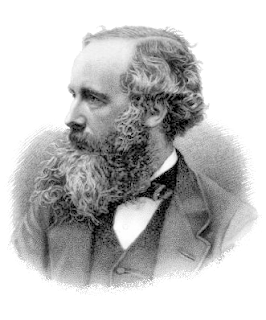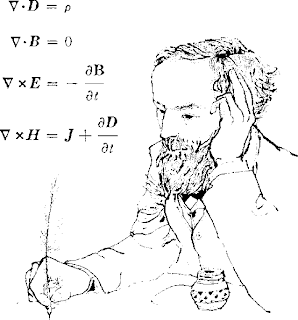24. JAMES CLERK MAXWELL
1831 - 1879.
The great British physicist James
Clerk Maxwell is best known for his formulation of the set of four equations
that express the basic laws of electricity and magnetism.
Those two fields had been investigated
extensively for many years before Maxwell, and it was well known that they were
closely related. However, although various laws of electricity and magnetism had been discovered that were true
in special circumstances, before Maxwell there was no overall, unified
theory. In his set of four short (though highly sophisticated)equations,
Maxwell was able to describe exactly the behavior and interaction of the electric and magnetic fields. By so
doing, he transformed a confusing mass of phenomena into a single, comprehensive
theory. Maxwell's equations have been employed extensively for the past
century in both theoretical and applied science.
The great
virtue of Maxwell's equations is that they are general
equations, which hold under all circumstances. All the previously known laws of electricity and magnetism can be derived from Maxwell's equations, as well as a large number of other, previously unknown results.
equations, which hold under all circumstances. All the previously known laws of electricity and magnetism can be derived from Maxwell's equations, as well as a large number of other, previously unknown results.
The most
important of these new results was deduced by Maxwell himself. From his
equations it can be shown that periodic oscillations of the electromagnetic
field are possible. Such oscillations, called. electromagnetic
waves, when once started will propagate outward through space. From his equations,
Maxwell was able to show that the speed of such electromagnetic waves would be
approximately 300,000 kilometers (186,000
miles) per second. Maxwell recognized that this was the same as the
measured speed of light. From this, he correctly concluded that light itself consists of electromagnetic waves.
measured speed of light. From this, he correctly concluded that light itself consists of electromagnetic waves.
Thus, Maxwell's equations are not only the basic
laws of electricity and magnetism, but are also the basic laws of optics!
Indeed, all the previously known laws of optics can be deduced from his
equations, as well as many facts and relationships previously undiscovered.
Visible light is not the only possible type of
electromagnetic radiation, Maxwell's equations indicated that other electromagnetic waves, differing from visible light in their wavelength and frequency, might
exist. These theoretical conclusions were later spectacularly confirmed by
Heinrich Hertz, who was able both to produce and to detect the invisible waves
whose existence Maxwell had predicted. A few years later, Guglielmo Marconi
demonstrated that those invisible waves could be employed for wireless communication,
and radio became a reality. Today, we use them for television as well.
X-rays, gamma rays, infrared rays,
and ultraviolet rays are other examples of electromagnetic radiation. All can be studied
by means of Maxwell's
equations.
Maxwell's equations are the basic laws of electricity and magnetism.
Although Maxwell's primary fame rests on his spectacular
contributions to electromagnetism and optics, he made important contributions
to many other fields of science, including astronomical theory and
thermodynamics (the study of heat). One of his special interests was the
kinetic theory of gases. Maxwell realized that not all of the molecules of a
gas move at the same speed. Some molecules move slowly, some rapidly, some at
Maxwell was born in 1831, in Edinburgh,
Scotland. He was extremely precocious: when
only fifteen years old he presented a scientific
paper to the Edinburgh Royal Society. He attended the University of
Edinburgh and graduated from Cambridge University. Maxwell spent most of his
adult life as a college professor, his last
position being at Cambridge. He was married, but had no children.
Maxwell is generally considered to be the greatest theoretical physicist in the
whole interval between Newton and Einstein. His brilliant career was ended prematurely, in 1879, when he died of cancer, shortly before his forty-eighth
birthday.


No comments:
Post a Comment